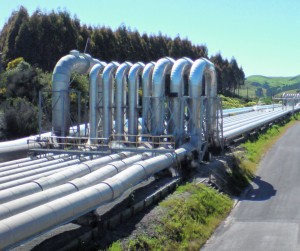WEDNESDAY, 18 JANUARY 2012
“For my generation, coming of age at the height of the Cold War, fear of nuclear winter seemed the leading existential threat on the horizon. But the danger posed by war to all humanity—and to our planet—is at least matched by climate change.”— Ban Ki-Moon, UN Secretary General
Climate change is arguably mankind’s greatest ever challenge. As governments, international organisations and industries struggle to come up with the least inconvenient solution to such a convoluted problem, the scale of the challenge continues to grow; we are still increasing our fossil fuel use by 2.5 per cent each year. The scientific consensus may not be clear on predictions for the future, but two things are indisputable: our climate is changing and we are at least in part responsible. More worrying is that we do not really know who, what, when or where will be affected, or how badly. The possibility of carbon dioxide capture and storage (CCS) was not recognised as early as other mitigation options, but it is now starting to receive some well-deserved attention.
This umbrella term covers a vast array of physical processes, techniques and equipment. Essentially it involves either separating carbon dioxide (CO2) from various large ‘point sources’, for example power plants, or simply removing it directly from the air. The CO2 can then be transported to a storage location, where the aim is long-term isolation from the atmosphere.
The first time CO2 was pumped underground was in the early 1970s, somewhat ironically by the oil industry, in a process called enhanced oil recovery. This involves injecting a gas that includes CO2—not air as it would catch fire—into an oil reservoir in order to force more ‘black gold’ up to the surface. This ‘CO2 flooding’ is still commonly used today, with over 120 registered sites worldwide.
However, CO2 capture was first considered by the Massachusetts Institute of Technology, which started a programme in 1989. This was quickly followed by commercial development, which was indirectly boosted by the Norwegian government’s new tax on CO2 emissions in 1991. But it was not until November 2002 that CCS really entered the global stage, when the Intergovernmental Panel on Climate Change (IPCC) decided to hold a workshop to assess the literature on the subject. Following this, at the 20th session of the IPCC in Paris in 2003, an outline and timetable were approved for CCS’s own Special Report. One of only seven, and the only one directly related to cutting emissions, the IPCC’s endorsement and subsequent preparation of this report shows the field’s high regard in scientific circles. However, it is still not getting the public attention or funding required to develop to its full potential.
The current scientific consensus favours underground storage of CO2 in depleted oil and gas reservoirs or saline aquifers. Natural gas is already stored temporarily in such sites and CO2 has been naturally stored there over geological time—millions of years, not just the thousands needed to make CCS feasible. The IPCC also found that globally many large point sources of CO2 are within 300 kilometres of potential geological storage sites, making transportation by pipelines relatively feasible and cheap. Without CCS it will cost up to 70 per cent more to hold global temperatures at 2°C above pre-industrial levels.
Nonetheless, some concerns remain. How much CO2 can be stored and how long for? The current lack of research on these issues, rather than acting as a barrier, should motivate further work. Observations from engineering models and geological analogues suggest that over 1000 years 99 per cent of CO2 can be retained in these storage sites. Below 750 metres it has been found that CO2 occupies a dense, supercritical state; so much so, in fact, that CO2 at 800 metres occupies just a tenth of the volume that it did at 250 metres. Despite this, the CO2 is still less dense than its surroundings so an impermeable ‘cap-rock’, overlying where the CO2 is injected, is also essential to prevent the gas simply rising back to the surface. Similar cap-rocks are found above oil reservoirs, so this is a potential avenue for collaboration with the oil industry.
For a global project of this magnitude, partnerships like this are the key. Not only must governments come to agreements on how best to utilise and develop CCS, but the fossil fuel industry must be brought in too. Their technical expertise, business interests and financial backing make them vital. As well as their experience in pumping CO2 into reservoirs and underground imaging, they are also the most knowledgeable when it comes to leak prevention and risk management.
The first operational CCS project was even started by Norway’s biggest oil company, Statoil, in 1996, in reaction to the Norwegian government’s implementation of a CO2 tax. Located in the North Sea, the Sleipner gas field produces natural gas with unusually high levels of CO2—around nine per cent, significantly higher than the 2.5 per cent required commercially. In order to avoid paying the $50 tax per tonne of CO2 released, and to explore this potentially lucrative technology, Statoil pumped all of the CO2 back deep underground. It has continued to do so until the present day, providing the longest case study for monitoring a storage reservoir.
In the following year, two forces in industry combined and worked out a mutually beneficial scenario—CO2 produced from fossil fuels in North Dakota, USA, was to be piped just over the border to the Weyburn oil field, Canada, where it could be used for enhanced oil recovery.
Though geological formations currently provide the best storage options, other ideas have been suggested. The ocean is a possibility: either by injecting CO2 and allowing it to dissolve, or sending it via pipes to great depths where it is denser than water and would form a ‘lake’. However, such alteration of the chemical environment could have disastrous consequences for marine life. Both experimentally and through modelling, injection of CO2 has been shown to significantly increase the acidity in our oceans, which would kill many marine organisms. Other possible proposals include injecting CO2 into reactive rock formations where some of it could be taken up, or passing it over methane-bearing sediments—this has the added advantage of displacing methane, which can then be used as a gas power source.
The primary limitation for all these scenarios has been, and will continue to be, cost. In the eyes of power companies, projected expenses of $25 to $150 per tonne of CO2 captured is not attractive. This increase comes largely from the energy required for capture, with transport and storage making up the rest. Many consumers may initially think that companies should bite the bullet, but inevitably such costs will be passed on to the consumer—full CO2 sequestration in the US would raise electricity bills by 50 to 100 per cent.
As technology advances, the cost of capture will inevitably fall. Combined with relatively short transport distances and economic incentives like enhanced oil recovery and methane extraction, this could lead to commercial CO2 storage becoming a reality with little to no government incentives. In the meantime, though, such incentives are crucial in order to make CCS more commercially viable and hence bring the technology forward. CCS’s potential to mitigate the effects of climate change, and provide a stepping-stone to entirely renewable energy generation, means it cannot remain on the periphery any longer.
Tom Bishop is a 4th year undergraduate in the Department of Earth Sciences
“For my generation, coming of age at the height of the Cold War, fear of nuclear winter seemed the leading existential threat on the horizon. But the danger posed by war to all humanity—and to our planet—is at least matched by climate change.”
— Ban Ki-Moon, UN Secretary General



